Wings of Love |
||||||||||||||||||||||||||||||||||||||||
 |
 |
|||||||||||||||||||||||||||||||||||||||
Knitted shawl with lace pattern in stockinette stitch and garter stitch. The piece is worked in DROPS Lace.
DROPS 181-4 |
||||||||||||||||||||||||||||||||||||||||
|
INFORMATION FOR THE PATTERN: RIDGE/GARTER STITCH (worked back and forth): 1 ridge = Knit 2 rows. PATTERN: See diagrams A.1 to A.12. The diagram shows all the rows in the pattern seen from the right side. Row 1 = right side. SHAPING: If you are using another yarn from yarn group A, you do not need to stretch the shawl to the right measurements, but dampen it and carefully lay it flat in the right shape. Allow it to dry. Repeat the process every time the shawl is washed. BINDING OFF TIP: To avoid the bind-off edge being tight, you can bind off with a needle a ½ size larger. ---------------------------------------------------------- SHAWL: The piece is worked back and forth with circular needle, top down. Work from the middle of the top edge with stockinette stitch and lace pattern and finish at the bottom with a border of lace pattern and garter stitch. Cast on 3 stitches with circular needle size 3 mm / US 2.5 and Lace - read KNITTING GAUGE above. Work according to diagram A.1 (= 3 stitches) - read PATTERN above. On the last row, insert 3 markers as shown in the diagram. When the whole of diagram A.1 has been completed in height, there are 27 stitches on the needle. WORK ACCORDING TO DIAGRAMS A.2 TO A.6 AS FOLLOWS FROM THE RIGHT SIDE: Work A.2 (= 4 stitches), A.3 (= 5 stitches – the first marker sits in the middle of A.3), A.4 (= 5 stitches – the second marker sits in the last stitch of A.4), A.5 (= 4 stitches), A.3 (= 5 stitches – the third marker sits in the middle of A.3) and A.6 (= 4 stitches). When the whole of diagrams A.2 to A.6 have been completed in height, there are 51 stitches on the needle. Repeat the increases as shown in A.x onwards – increase alternately 4 and 8 stitches on each row from the right side (i.e. 12 increased stitches for every repeat of A.x in height), the increased stitches are worked in stockinette stitch on each side of A.3. Repeat as shown in A.x 24 times in total in height = 339 stitches on the needle. The piece measures approx. 36 cm / 14¼". On the next row from the right side, work and increase 4 stitches as shown on the first row of A.x = 343 stitches. Purl 1 row from the wrong side (the edge stitch in each side is worked in GARTER STITCH – see description above, throughout the whole piece). Knit 1 row from the right side and increase 1 stitch inside the edge stitch in garter stitch in each side and increase 1 stitch only by the mid-stitch (= 3 stitches increased) = 346 stitches on the needle and purl 1 row from the wrong side. You do not need the 3 markers from here. WORK ACCORDING TO DIAGRAMS A.7 TO A.9 AS FOLLOWS FROM THE RIGHT SIDE: Work 1 edge stitch in garter stitch, A.7 over 4 stitches, repeat A.8 until there are 5 stitches left on the needle (= 21 repeats of 16 stitches), A.9 over 4 stitches and 1 edge stitch in garter stitch. NOTE! On the 11th row in the diagram, increase 2 stitches in each repeat of A.7, A.8 and A.9. On the 17th row increase 2 stitches in each of A.7 and A.9. When the whole of diagrams A.7 to A.9 have been completed in height, there are 430 stitches on the needle. WORK ACCORDING TO DIAGRAMS A.10 TO A.12 AS FOLLOWS FROM THE RIGHT SIDE: Work 1 edge stitch in garter stitch, A.10 over 7 stitches, repeat A.11 until there are 8 stitches left on the needle (= 23 repeats of 18 stitches), A.12 over 7 stitches and 1 edge stitch in garter stitch. NOTE! On the 17th row in the diagram increase 3 stitches in A.10, 1 stitch in A.11 and 2 stitches in A.12. On the 21st row increase 2 stitches in A.10 and in A.12. When the whole of diagrams A.10 to A.12 have been completed in height, there are 496 stitches on the needle – loosely bind off on the last row from the wrong side - read BINDING OFF TIP above. STRETCHING: Lay the shawl in lukewarm water until it is thoroughly wet. Carefully press the water out of the shawl – it must not be twisted, then roll the shawl in a towel and press again to remove more water – the shawl will now just be damp. If you are using another yarn from yarn group A - read SHAPING above. Lay the shawl on a floor rug or mattress – pull it carefully into shape and use pins to fasten it in place. Allow the shawl to dry. Repeat the process every time the shawl is washed. |
||||||||||||||||||||||||||||||||||||||||
Diagram explanations |
||||||||||||||||||||||||||||||||||||||||
|
||||||||||||||||||||||||||||||||||||||||

|
||||||||||||||||||||||||||||||||||||||||
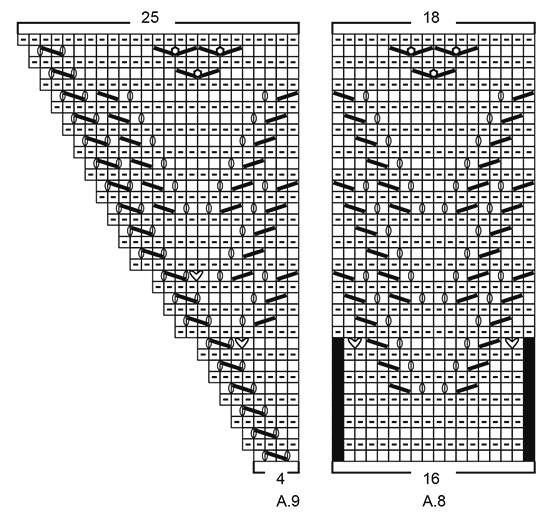
|
||||||||||||||||||||||||||||||||||||||||
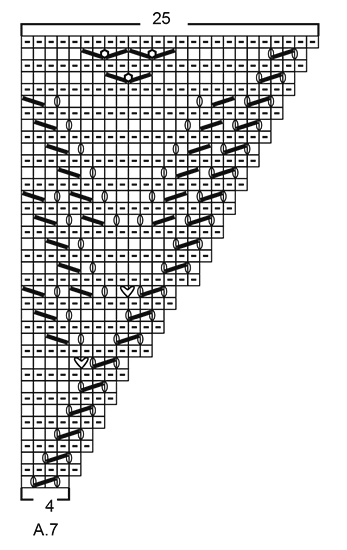
|
||||||||||||||||||||||||||||||||||||||||
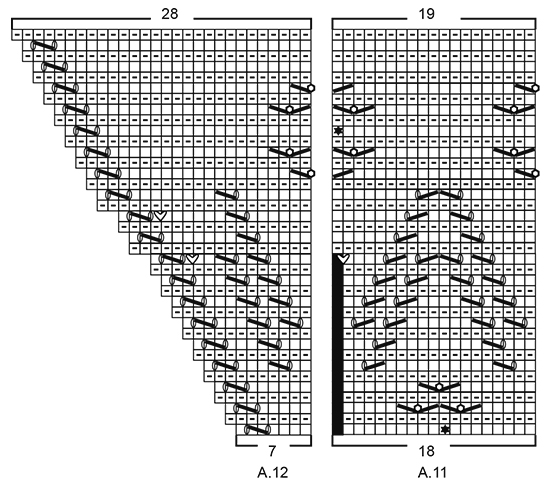
|
||||||||||||||||||||||||||||||||||||||||
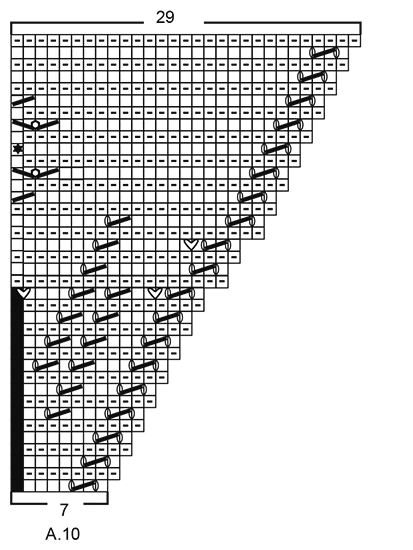
|
||||||||||||||||||||||||||||||||||||||||
|
Have you made this or any other of our designs? Tag your pictures in social media with #dropsdesign so we can see them! Do you need help with this pattern?You'll find tutorial videos, a Comments/Questions area and more by visiting the pattern on garnstudio.com. © 1982-2024 DROPS Design A/S. We reserve all rights. This document, including all its sub-sections, has copyrights. Read more about what you can do with our patterns at the bottom of each pattern on our site. |
||||||||||||||||||||||||||||||||||||||||









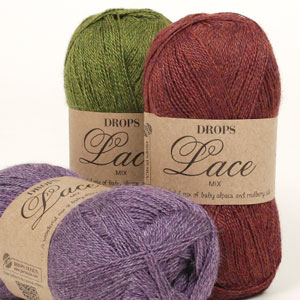





















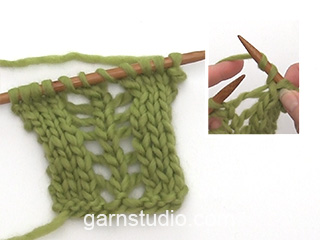





































Comments / Questions (79)
Et à quel moment je dois-je integré le diagramme A7 ? bien à vous
01.08.2018 - 15:46DROPS Design answered:
Bonjour Mme Decamps, quand vous avez 346 m (après avoir répété A.2-A.6 et augmenté comme indiqué), vous tricotez A.7 à A.9 comme indiqué au paragraphe suivant: 1 m point mousse, A.7, on répète 21 fois A.8 , A.9, 1 m point mousse. Bon tricot!
01.08.2018 - 16:02MERCI POUR VOTRE RéPONSE ET VOTRE RAPIDIté
01.08.2018 - 15:39Bonjour je suis bloqué après le diagramme A6 . J\\\\\\\'AI 51 MAILES ET JE NE SAIS PAS PAR QUOI JE DOIS RECOMMENCER LE RANG SUIVANT AVEC QUEL DIAGRAMME . BIEN àVOUS
01.08.2018 - 15:22DROPS Design answered:
Bonjour Mme Decamps, quand vous avez tricoté A.2 à A.6 1 fois en hauteur et que vous avez 51 mailles, vous répétez maintenant les rangs indiqués dans A.X = les 4 derniers rangs des diagrammes A.2-A.6. Vous allez ainsi augmenter alternativement 4 et 8 mailles tous les rangs sur l'endroit = vous augmentez 12 mailles au total à chaque fois que A.x est tricoté en hauteur. Continuez ainsi jusqu'à ce que vous ayez tricoté 24 fois A.x, vous avez alors 339 mailles sur l'aiguille. Bon tricot!
01.08.2018 - 15:27Could you please check what happened to the diagrams after the last corrections. I don\'t see them any more.\r\nThank you!
04.06.2018 - 08:17DROPS Design answered:
Dear Mrs Moshanova, thanks for your feedback, diagrams should be soon available. Happy knitting!
04.06.2018 - 09:53Merci d'avance car je ne peux pas continuer le modéle sans les symboles qui manquent sur les diagrammes . J'attends avec impatience
15.05.2018 - 05:42Bonjour ,jusque là pas de soucis ,mais en regardant les légendes des diagrammes ,je ne trouve pas le symboles 8 (le coeur ) et le symbole 13 ( le grand triangle noir) sur les diagrammes . Merci le modéle est magnifique
12.05.2018 - 06:37DROPS Design answered:
Bonjour Mme Jolivot, merci pour votre retour, nos stylistes vont vérifier, merci d'avance pour votre patience.
14.05.2018 - 09:29Ich habe ein paar Probleme mit der Strickschrift. Wird A2 bis A6 zuerst abgestrickt und danach A.x. Wiederholt? Und wird das A.x von A.2/A.4 EINMAL gestrickt, dann das A.x. Von A.5/A.6 EINMAL und diese beiden abwechselnd dann 24mal? Und wo sond die krausrechts-Randmaschen bei A.5 hin? Die Kästchen in A.4 am Rand sind auch nicht erklärt. Liebe Grüße
10.04.2018 - 12:08DROPS Design answered:
Liebe Julia, zuerst stricken Sie A.1 bis A.6 (= 9 Reihe), dann A.x in A.1 bis A.6 wiederholen (= 4 Reihen), A.x wird insgesamt 24 Mal gestrickt (25 Mal mit der ersten Mal A.1-A.6 in der Höhe) = 51 M + (12 Zunahme x 25) = 339 M. Die letzte M in A.4 = 4. Symbol unter Diagram Text. Die erste Masche in A.5 wird glatt re gestrickt. Die Randmaschen sind die 1. Masche in A.2 und die letzte M in A.6 (= Randmaschen = 5. Symbol). Viel Spaß beim stricken!
10.04.2018 - 13:29På varv 11 i diagram A.8 är det två ovala tecken som till skillnad från de dubbla omslagen saknar en vertikal linje i mitten, vad betyder dessa? Jag undrar även vad cirklarna (utan vertikala linjer i mitten) på varv 35 och 37 betyder?
16.03.2018 - 20:02DROPS Design answered:
Hej Louise, det betyder också omslag men som skall stickas vridet på nästa varv, du ser at på detta varvet i A.8 ökas från 16 till 18 maskor. På varv 35 och 37 är det symbolen som betyder att du gör 3 omslag, se diagramtexten hur de stickas. Lycka till!
20.03.2018 - 10:08Fragen entstehen erst beim Stricken.
04.03.2018 - 21:03Kommentar habe ich schon geschrieben.
04.03.2018 - 21:01